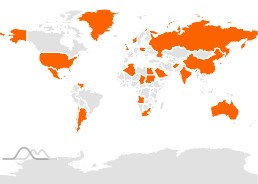
Written by Anna Trammell
In 1871, a group of Pimas took a young Yavapai boy named Wassaja captive. From there, he would begin on a journey that would eventually lead him to Urbana, Illinois. Political activist, writer, physician, and the first Native American graduate of the University of Illinois, his legacy is far-reaching.
Wassaja, a term that could be translated to “beckoning” or “signaling,” was born to the Yavapai in Arizona circa 1867. Drought in the area around this time and the appearance of settlements encroaching on Native American land contributed to an increase in violent clashes between the Yavapai and the Pimas. It was in such a clash that Wassaja and his sisters were taken captive. Shortly thereafter, he was sold for a sum of thirty silver dollars to Carlo Gentile, an Italian immigrant and photographer. [1]
Gentile gave Wassaja the name Carlos Montezuma. After Gentile’s quest for gold proved fruitless, the pair spent time in several locations before settling in Chicago. It was there that Montezuma found himself briefly working as a performer in an early Buffalo Bill stage production. The association with the production only lasted a short time and by 1875 Carlos was completely focused on his studies.[2]

Gentile and Montezuma continued a transient lifestyle over the following few years spending short periods in New York and Galesburg, Illinois. When Montezuma was 11, Gentile turned him over to the New American Baptist Mission Society. The Society elected to place him into the care of pastor William Stedman of the Firth Baptist Church of Urbana. In Urbana, he continued his education and went on to enroll in the University of Illinois (then the Illinois Industrial University). Montezuma thrived at the University. He joined the Adelphic Society where he honed his natural skills as an orator and was elected president of the class of 1884. [3]
He returned to Chicago where he attended the Chicago Medical College and worked in a pharmacy. After graduation, he became a physician for the Bureau of Indian Affairs. Montezuma, who supported the abolishment of reservations, found this experience discouraging. He then spent a period working for the Carlisle Indian Industrial School before returning to Chicago once again to begin a private practice. [4] During this time, he began what would be a lifelong effort to preserve the land and water rights of the Yavapai. He became an outspoken critic of the Bureau of Indian Affairs and testified against them in a hearing investigating their expenditures. [5]
In 1915, Montezuma delivered a rousing speech at the Society of American Indians Conference at the University of Kansas. He proclaimed, “We must act as one. Our hearts must throb with love- our souls must reach to God to guide us- and our bodies and souls must be used to gain our people’s freedom. In behalf of our people, with the spirit of Moses, I ask this- The United States of America- Let my people go.” [6]

In 1916, Montezuma established Wassaja: Freedom’s Signal for the Indians, a newsletter through which he critiqued the U.S. Government and discussed issues related to the future of Native Americans. He saw this paper as his response to the Society of American Indians’ American Indian Magazine which he felt focused on presenting stories of American Indian culture to a white audience rather than dealing with issues of importance to Native Americans. Montezuma continued to publish the newsletter for the remainder of his life. [7]
In 1922, Montezuma returned home to the Yavapai to die among his people. His tombstone is inscribed with both “Wassaja” and “Carlos Montezuma, M.D.” [8] Next fall, the University of Illinois’ newest residence hall will be named Wassaja Hall in honor of the first Native American graduate. [9]
[1] Iverson, Peter. Carlos Montezuma and the Changing World of the American Indians. Albuquerque: University of New Mexico Press, 1982.
[2] Franch, John. “Torn Between Two Worlds: The Life of Carlos Montezuma.” Illinois Alumni. September/October 2006: 22-26.
[4] Iverson, Peter. Carlos Montezuma and the Changing World of the American Indians. Albuquerque: University of New Mexico Press, 1982.
[5] Center of Southwest Studies, Fort Lewis College. “Guide to the Scholarly Resources Microfilm Edition of the Papers of Carlos Montezuma, M.D.”
[6] Montezuma, Carlos. “Let My People Go.” American Indian Magazine. January-March 1916: 32-33.
[7] Zuck, Rochelle Raineri. “’Yours in the Cause’: Readers, Correspondents, and the Editorial Politics of Carlos Montezuma’s Wassaja.” American Periodicals. March 2012: 72-93.
[8] Franch, John. “Torn Between Two Worlds: The Life of Carlos Montezuma.” Illinois Alumni. September/October 2006: 22-26.
[9] “Wassaja Hall.” University of Illinois Housing.
